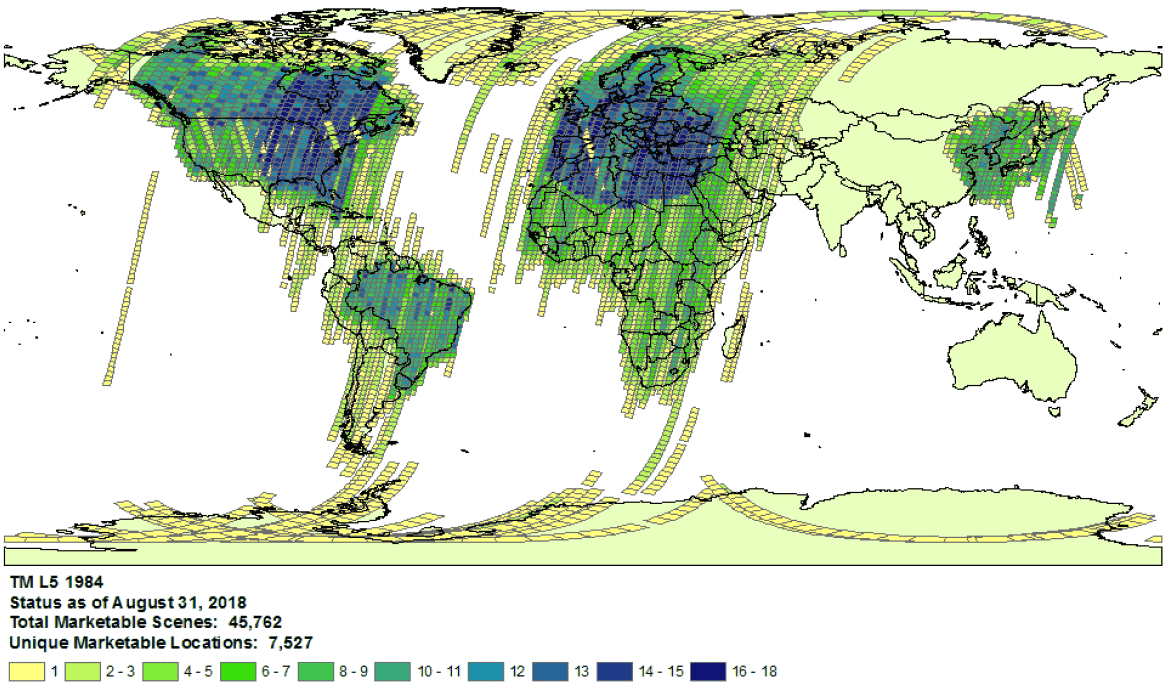Mục đích của tài liệu này là giúp bạn xác định xem có tài sản nào bị thiếu trong Danh mục dữ liệu Earth Engine (hiện là Landsat, Sentinel và MODIS) hay không.
Các bước được nêu ra mô tả cách:
Kiểm tra các thành phần có sẵn trong danh mục của Earth Engine và các nhà cung cấp.
Thu thập thông tin cần thiết để gửi xác nhận về tài sản bị thiếu cho nhóm dữ liệu Earth Engine.
Những điều thường gặp cần cân nhắc
Cấp độ xử lý: không phải hình ảnh nào cũng có sẵn cho một cấp độ xử lý hoặc sản phẩm nhất định. Ví dụ: hình ảnh chất lượng thấp có thể không được xử lý đến mức cao nhất.
Phạm vi không gian và thời gian: không đảm bảo tần suất đều đặn cho mỗi tập dữ liệu. Sự khác biệt về việc giao việc cho cảm biến, chất lượng hình ảnh và việc quản lý bản lưu trữ có thể ảnh hưởng đến khả năng cung cấp dữ liệu của nhà cung cấp.
 Ví dụ về mức độ bao phủ của dữ liệu thu thập của Landsat 5 trong năm 1984.
Ví dụ về mức độ bao phủ của dữ liệu thu thập của Landsat 5 trong năm 1984.
- Lựa chọn nhà cung cấp: dữ liệu được nhập vào Danh mục dữ liệu Earth Engine từ một nhà cung cấp đã chọn cho mỗi tập dữ liệu. Có thể nhà cung cấp không cung cấp bản lưu trữ đầy đủ về nhiệm vụ. Ví dụ: các tập dữ liệu Landsat được nhập từ kho lưu trữ USGS. Kho lưu trữ này được biết là thiếu hình ảnh từ một số trạm thu nhận trong một số khoảng thời gian nhất định (xem nỗ lực của LGAC để biết thêm thông tin).
Landsat
Dữ liệu Landsat được nhập từ Cơ quan Khảo sát Địa chất Hoa Kỳ (USGS).
Xác nhận tình trạng cung cấp dữ liệu Landsat tại thời điểm và khu vực bạn quan tâm.
Tìm kiếm trong Earth Engine để nhận danh sách tất cả tài sản tại thời điểm và khu vực mà bạn quan tâm. Hãy cẩn thận để đảm bảo không có thành phần nào bị vô tình lọc ra trong mã của bạn. Dưới đây là tập lệnh mẫu; hãy đảm bảo bạn đang nhập tập hợp có cấp và cấp xử lý phù hợp (tìm hiểu thêm về cấu trúc tập hợp Landsat).
Tìm các tài sản có thể bị thiếu trong danh mục USGS Earth Explorer (xem hướng dẫn trợ giúp để biết các bước chi tiết về cách tìm kiếm và chọn tập dữ liệu). Đảm bảo bạn đang so sánh đúng sản phẩm và cấp độ xử lý (xem cấu trúc tập hợp Landsat). Xin lưu ý rằng các sản phẩm độ phản chiếu bề mặt chỉ được tạo cho hình ảnh Landsat có cấp xử lý là L1TP.
Chia sẻ bằng chứng chi tiết về việc thiếu thành phần bằng cách gửi một vé hỗ trợ kèm theo mã sản phẩm của nhà cung cấp và đường liên kết đến tập lệnh Trình chỉnh sửa mã Earth Engine xác nhận việc thiếu thành phần.
Sentinel
Dữ liệu Sentinel được nhập từ trang web Copernicus Dataspace.
Xác nhận phạm vi quan sát của Sentinel tại thời điểm và khu vực bạn quan tâm (xem thông tin chi tiết về nhiệm vụ).
Lưu ý: Các sản phẩm Sentinel-2 cấp 2A chỉ được tạo một cách có hệ thống tại phân đoạn mặt đất trên Châu Âu kể từ tháng 3 năm 2018 và quá trình sản xuất đã được mở rộng ra toàn cầu vào tháng 12 năm 2018 (xem Hướng dẫn sử dụng ESA để biết thêm thông tin chi tiết). Cuối cùng, các tệp này sẽ được tạo lại trong Bộ sưu tập 1.
Tìm kiếm trong Earth Engine để nhận danh sách tất cả tài sản tại thời điểm và khu vực mà bạn quan tâm. Hãy cẩn thận để đảm bảo không có thành phần nào bị vô tình lọc ra trong mã của bạn. Dưới đây là một tập lệnh mẫu; hãy đảm bảo bạn đang nhập bộ sưu tập ở cấp độ xử lý phù hợp.
Tìm các thành phần có thể bị thiếu trong danh mục Copernicus.
Chia sẻ bằng chứng chi tiết về việc thiếu thành phần bằng cách gửi một vé hỗ trợ kèm theo mã sản phẩm của nhà cung cấp và đường liên kết đến tập lệnh Trình chỉnh sửa mã Earth Engine xác nhận việc thiếu thành phần.
MODIS
Dữ liệu MODIS được nhập từ Trung tâm lưu trữ chủ động phân phối quy trình trên đất liền (LP DAAC).
Tìm kiếm trong Earth Engine để nhận danh sách tất cả tài sản tại thời điểm và khu vực mà bạn quan tâm. Hãy cẩn thận để đảm bảo không có thành phần nào bị vô tình lọc ra trong mã của bạn. Sau đây là một tập lệnh mẫu; hãy đảm bảo bạn đang nhập sản phẩm dự định.
Tìm những thành phần có thể bị thiếu trong Bể dữ liệu USGS mà chưa được thêm vào Earth Engine. Chuyển đến thư mục thích hợp và xác định các thư mục mới nhất hiện có.
Các tập dữ liệu bắt đầu bằng "MOD" nằm trong "Terra MODIS"
Các tập dữ liệu bắt đầu bằng "MYD" nằm trong "Aqua MODIS"
Các tập dữ liệu bắt đầu bằng "MCD" nằm trong "MODIS kết hợp"
Các tập dữ liệu bắt đầu bằng "VNP" nằm trong "S-NPP VIIRS"
Chia sẻ bằng chứng chi tiết về việc thiếu thành phần bằng cách gửi một vé hỗ trợ kèm theo mã sản phẩm của nhà cung cấp và đường liên kết đến tập lệnh Trình chỉnh sửa mã Earth Engine xác nhận việc thiếu thành phần.
